Seed paper is eco-friendly, biodegradable, and embedded with plant seeds that grow after use, making it ideal for sustainable brochures. Glossy paper offers vibrant colors and a smooth finish, enhancing visual appeal but with a higher environmental impact.
Table of Comparison
| Feature | Seed Paper | Glossy Paper |
|---|---|---|
| Material Type | Recycled paper embedded with plant seeds | Coated paper with a shiny, smooth finish |
| Environmental Impact | 100% biodegradable, promotes planting and sustainability | Non-biodegradable, often coated with plastic or chemicals |
| Texture | Rough, natural feel | Smooth, reflective surface |
| Print Quality | Matte finish, vibrant but less sharp detail | High gloss, sharp, and vivid colors |
| Durability | Moderate; absorbs moisture easily | High; resistant to wear and moisture |
| Use Case | Eco-friendly branding, promotional materials with sustainability focus | High-impact marketing, photo-quality brochures |
| Cost | Higher due to specialty production | Generally lower and widely available |
Introduction to Brochure Paper Types
Brochure paper types vary primarily between seed paper and glossy paper, each serving distinct purposes and audience preferences. Seed paper integrates embedded seeds, making it an eco-friendly option that encourages sustainability and environmental awareness, ideal for green marketing campaigns. Glossy paper offers a high-shine finish that enhances color vibrancy and image clarity, perfect for visually striking, professional brochures targeting mainstream consumers.
What is Seed Paper?
Seed paper is an eco-friendly material embedded with plant seeds that can be planted after use, promoting sustainability and reducing waste in brochure marketing. Glossy paper, in contrast, features a smooth, shiny finish that enhances image vibrancy but lacks environmental benefits. Choosing seed paper for brochures supports green initiatives by combining effective advertising with biological value, while glossy paper prioritizes visual appeal and durability.
What is Glossy Paper?
Glossy paper is a highly reflective, smooth-surfaced paper commonly used for brochures to enhance color vibrancy and image sharpness, making visuals appear more vivid and attractive. Its coated finish reduces ink absorption, resulting in crisp details and a polished, professional look perfect for marketing materials. Unlike seed paper, which is eco-friendly and biodegradable, glossy paper prioritizes aesthetic appeal and durability in print quality.
Environmental Impact: Seed Paper vs Glossy Paper
Seed paper significantly reduces environmental impact by being biodegradable and embedded with plant seeds that promote sustainable growth after use, unlike glossy paper which is typically coated with plastic or chemical finishes that hinder recycling and contribute to landfill waste. The production of seed paper often utilizes recycled materials and natural fibers, minimizing carbon footprint, whereas glossy paper manufacturing consumes higher energy and involves toxic substances detrimental to ecosystems. Choosing seed paper for brochures supports eco-friendly practices by aligning with circular economy principles, while glossy paper choices pose challenges for waste management and environmental conservation.
Aesthetics and Visual Appeal Comparison
Seed paper offers a unique, textured surface that emphasizes eco-friendly aesthetics, giving brochures a natural, tactile appeal that resonates with environmentally conscious audiences. Glossy paper provides a smooth, reflective finish that enhances color vibrancy and sharp image details, making visuals pop for a polished, high-impact look. Choosing between seed paper and glossy paper depends on whether the priority is a rustic, organic feel or sleek, vibrant presentation for the brochure design.
Durability and Longevity of Both Papers
Seed paper offers biodegradable qualities but generally lacks the durability and longevity of glossy paper, as it is prone to tearing and water damage. Glossy paper provides enhanced durability with its smooth, coated surface that resists wear and moisture, ensuring longer-lasting brochures. For projects prioritizing durability and extended visual appeal, glossy paper is typically the preferred choice over seed paper.
Customization and Print Quality Differences
Seed paper offers eco-friendly customization options with textured, natural fibers that enhance the tactile appeal of brochures, making them ideal for brands emphasizing sustainability. Glossy paper provides vibrant, high-resolution print quality with sharp color contrasts and smooth finishes, perfect for visually striking images and detailed graphics. Customization on glossy paper allows for various coatings and finishes, resulting in a professional look, while seed paper supports unique, biodegradable designs that promote environmental responsibility.
Cost Analysis: Seed Paper vs Glossy Paper
Seed paper generally incurs higher initial costs due to its eco-friendly materials and specialized production process compared to glossy paper, which is mass-produced and more economically priced. Despite the premium, seed paper can offer cost savings in long-term brand value and sustainability efforts, appealing to environmentally conscious consumers. Glossy paper provides a lower upfront expense but may result in increased environmental disposal costs, influencing overall financial and ecological impacts.
Ideal Use Cases for Each Paper Type
Seed paper excels in eco-friendly, sustainable marketing campaigns, ideal for brands emphasizing environmental responsibility and wishing to leave a memorable, interactive impression by allowing recipients to plant the brochure. Glossy paper is best suited for high-impact visual presentations, such as luxury product brochures or fashion catalogs, offering vibrant colors and sharp images that capture attention in retail and corporate settings. Choosing seed paper aligns with green branding efforts, while glossy paper enhances aesthetic appeal in professional, high-quality promotional materials.
Making the Right Choice for Your Brochure
Seed paper offers an eco-friendly and biodegradable option for brochures, embedding plant seeds that grow after use, ideal for brands emphasizing sustainability. Glossy paper provides vibrant colors and a smooth, reflective finish that enhances visual appeal and durability, suitable for high-impact marketing materials. Choosing between seed paper and glossy paper depends on your brochure's purpose, target audience, and commitment to environmental responsibility versus visual prominence.

Infographic: Seed paper vs Glossy paper for Brochure
 azmater.com
azmater.com